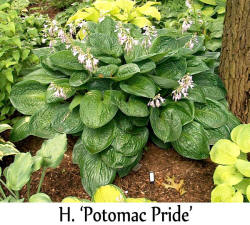 Growth rate in hostas does not refer to how
fast they come up in the spring and develop their new leaves.
Rather, it relates to how rapidly they add new buds i.e. divisions,
to the crown so that the clump can enlarge. As discussed previously,
the size categories deal with mature clumps after 5 or 6 years of
growth. That clump size, especially its width, will be determined by
the number of new buds the plant has added each year since first
being planted.
Growth rate in hostas does not refer to how
fast they come up in the spring and develop their new leaves.
Rather, it relates to how rapidly they add new buds i.e. divisions,
to the crown so that the clump can enlarge. As discussed previously,
the size categories deal with mature clumps after 5 or 6 years of
growth. That clump size, especially its width, will be determined by
the number of new buds the plant has added each year since first
being planted.
The
registration form refers to three growth
rate categories; Slow, Medium and Fast. Of course, in the individual
garden, these are relative classifications, since how a particular
hosta responds may be governed by local growing conditions. So, to
guarantee that Cultivar A will always add 5 new divisions during a
growing season would be impossible to insure. However, in any
garden, a slow growing type should expand at a rate that is slower
than that of a medium growing plant which, in turn, should be slower
than a fast grower.
 Fast growing cultivars
such as H. 'Potomac
Pride' may put on 20 divisions
or more over a 5 year stretch while a slow grower like H. 'Aspen
Gold' may only add 4 or
5. There are a few generalities that relate to the rate at which a
hosta will grow. For instance, many of the smaller hostas such as
the Tiara
Series that are used for the front of the border or for
ground covers mostly grow at a fast rate. Often, you can plant a
single bud division in the fall and by the following autumn there
will be 3 or 4 new divisions that have been generated.
Fast growing cultivars
such as H. 'Potomac
Pride' may put on 20 divisions
or more over a 5 year stretch while a slow grower like H. 'Aspen
Gold' may only add 4 or
5. There are a few generalities that relate to the rate at which a
hosta will grow. For instance, many of the smaller hostas such as
the Tiara
Series that are used for the front of the border or for
ground covers mostly grow at a fast rate. Often, you can plant a
single bud division in the fall and by the following autumn there
will be 3 or 4 new divisions that have been generated.
Another generality might be that hostas with a
high level of variegation will put on divisions more slowly than
similar hostas that are fully green. Having a lot of white or yellow
variegation in the foliage means a lack of chlorophyll. This can
lead to "delicate" plants that are more easily stressed by lack of
water or too much hot sunlight late in the summer resulting in
slower growth and expansion.



